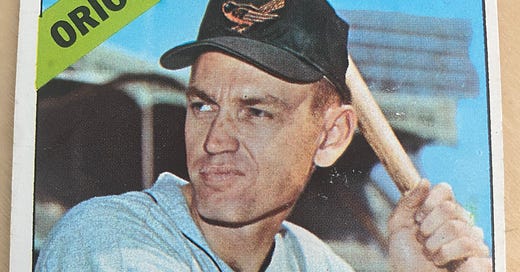Classic Card: Norm Siebern, 1966
It looks fine at first glance, but there's a problem: It doesn't reflect the trade that sent him out of Baltimore months before the 1966 season began.
Of all things, the enduring influence of the New York Yankees led to a tall Midwesterner named Norm Siebern playing first base for the Orioles as they became American League contenders in the 1960s.
A few years earlier, when Orioles ownership had grown weary of manager/GM Paul Richards spending their money a little too freely, they’d turned to the Yankees, the sport’s longstanding superpower, and hired Lee MacPhail to replace Richards as GM. MacPhail had run the Yankees’ farm system for a decade.
MacPhail eventually mined his pinstripe connection and hired another Yankee stalwart, Hank Bauer, to manage the Orioles in 1964. An outfielder, Bauer had played on no less than seven World Series-winning Yankee teams.
One of Bauer’s first moves in Baltimore was to OK a trade for Siebern, who’d been his teammate on the Yankees in the ‘50s and also on the Kansas City A’s in the early ‘60s. (Bauer and Siebern both went from first to worst, i.e., from the Yankees to the A’s, in the trade that brought Roger Maris to the Yankees.)
The Orioles and A’s swapped first basemen in their 1964 deal, with Jim Gentile leaving Baltimore for Kansas City and Siebern arriving in exchange.
The Orioles were seeking to add consistency without subtracting power. Siebern, 30, had grown up in the Yankees’ system, won World Series rings and become a steady producer in Kansas City; over the three seasons before he came to Baltimore, he’d averaged 20 home runs and 99 RBIs. Meanwhile, Gentile’s production had dropped significantly since his 46-homer explosion a few years earlier.
As it turned out, Siebern made the American League All-Star team in 1964, but not because he hit for power. He led the league in walks and scored 92 runs on a Baltimore team that won 97 games and challenged the Yankees for the pennant, ultimately finishing two games out. Gentile produced far more home runs than Siebern (28 to 12) and also more RBIs (71 to 56) while playing for the last-place A’s. In his Bird Tapes interview, Gentile suggested the Orioles might have won the 1964 pennant if they’d kept him as their first baseman instead of trading him.
Regardless, the Orioles’ first base job began to slip from Siebern’s grasp in 1965. Not even having a buddy as the manager could save him when the club moved a young slugger named Boog Powell to first base after having initially considering him an outfielder. Powell more than doubled Siebern’s home run and RBI totals in 1965 as Siebern was relegated to a part-time role. After the season, the Orioles traded Siebern to the California Angels for a fleet outfielder named Dick Simpson.
What Siebern was worth as he departed may have been his greatest contribution to the Orioles. Shortly after they acquired Simpson, they included him in the package that brought Frank Robinson to Baltimore.
Siebern’s Topps card for 1966 (pictured at the top of this post) obviously was produced long before the season began. It looked fine at first glance as he gripped the bat with a determined expression, preparing to unleash the left-handed swing that produced 132 home runs in the majors during a 12-year career. But there was a problem with the card: It had Siebern still playing for the Orioles, as if he’d never been traded.
Wrong.
Powell played first base for the World Series-winning Orioles in 1966, and he was critical to their success, totaling 34 home runs and 109 RBI.
Siebern hit five home runs for the Angels.







I have that card. It was his 66 Topps card. It was fairly common back then for the card to not reflect a trade in the off-season.
I think this was before the trade in '66. I'm a card afecino or however you pronounce it but that's my guess.